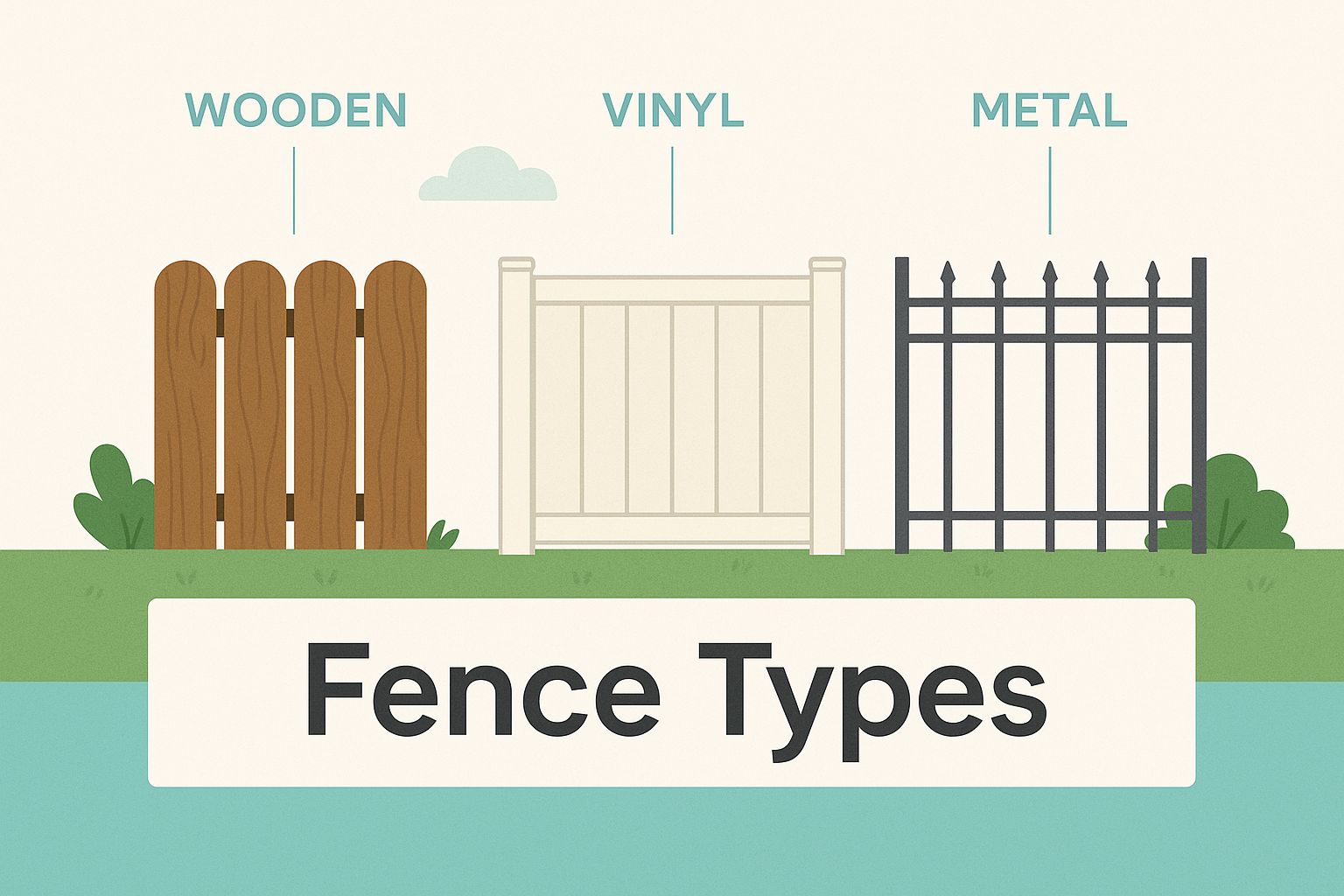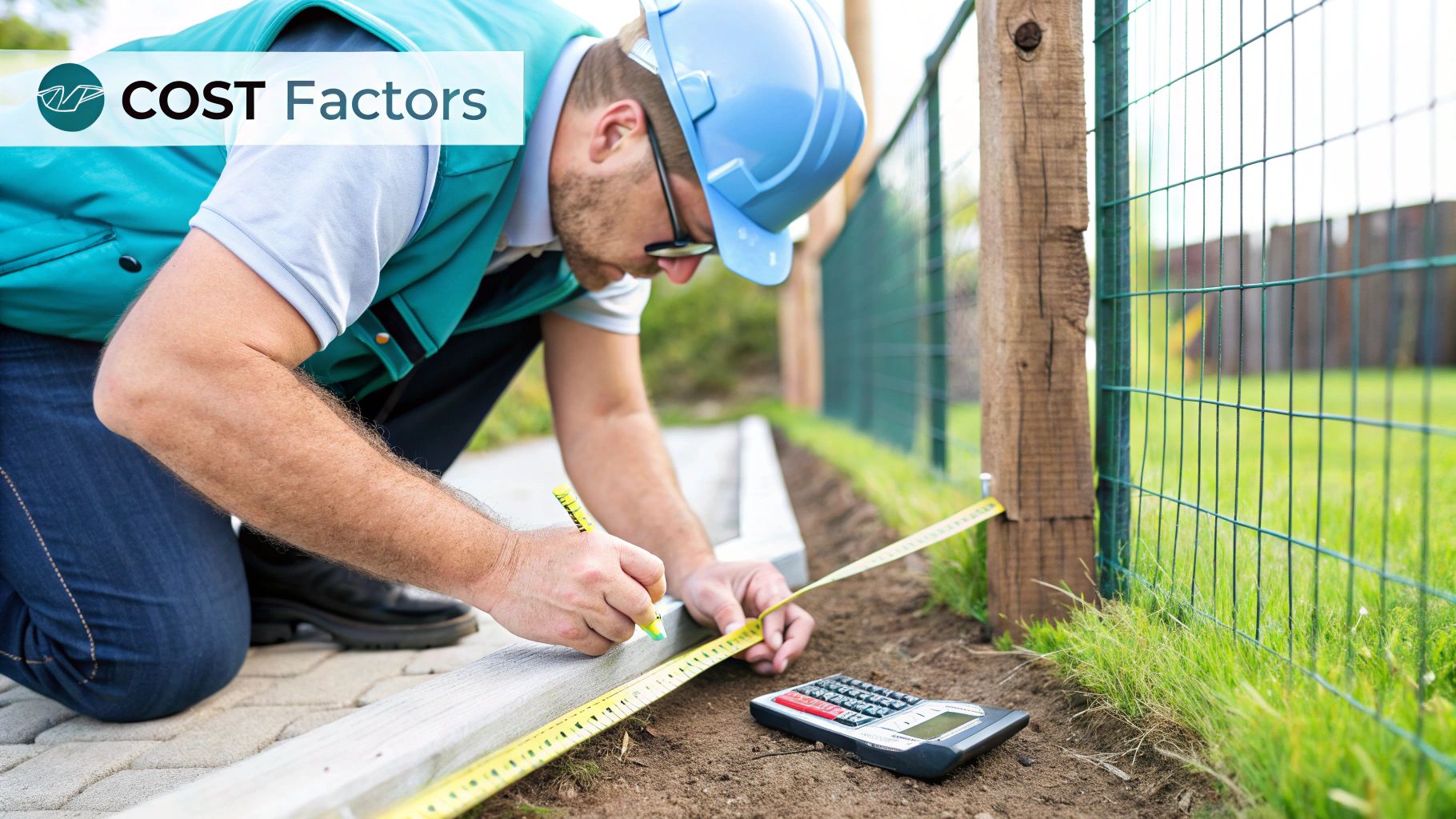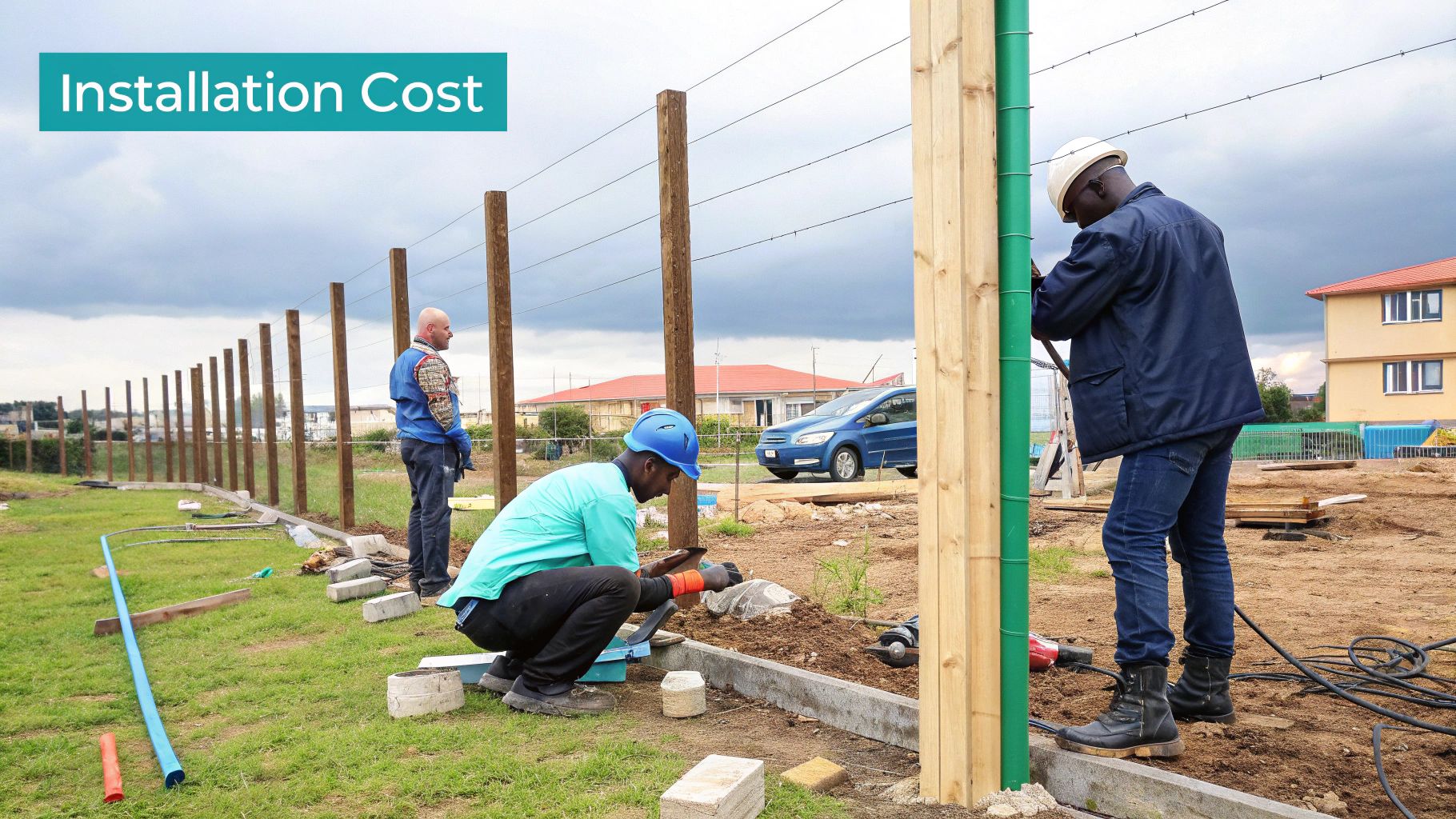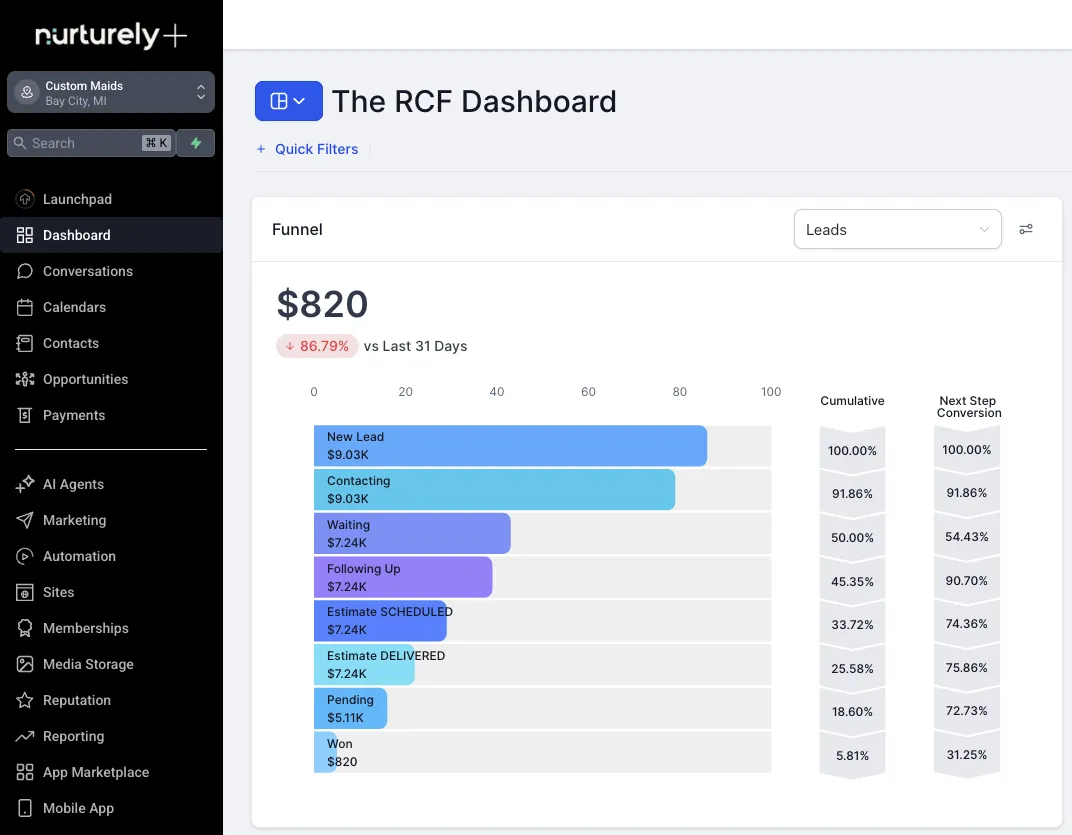How Much Do Fences Cost?
How Much Do Fences Cost? A Complete Pricing Guide
So, you're thinking about a new fence. The first question that probably popped into your head was, "How much is this going to cost me?" It’s a fair question, but the answer isn't a single number.
On average, most homeowners find themselves spending somewhere between $1,500 and $7,000 for a new fence, with a common middle ground right around $4,000. But that's a huge range. The final price tag really depends on what you're building with, the size of your yard, and what contractors charge in your area.
What Drives Your Total Fence Cost
Trying to nail down the cost of a fence is a bit like pricing out a car. Sure, there’s a base model price, but as soon as you start adding features, upgrading the engine, or picking a premium color, that number starts to climb. Your total investment is a mix of a few key ingredients.
Getting a handle on these pieces is the first step to building a realistic budget and, more importantly, avoiding any nasty surprises when the final invoice arrives.
Breaking Down the Core Price Factors
When it comes down to it, your bill is shaped by a handful of major players. While materials and labor are the two heavy hitters, other things can definitely move the needle.
Fence Material: This is almost always the biggest variable. A simple chain-link fence will be on the more affordable end of the spectrum, while materials like premium composites or classic wrought iron will sit at the top.
Labor and Installation: Don't underestimate this part. Professional installation is a huge piece of the puzzle, typically making up 40-50% of your total project cost. You're paying for experience, the right tools, and the time it takes to do the job right.
Project Size: This one’s straightforward. The total length of your fence—measured in linear feet—is a direct multiplier. A bigger yard means more materials and more work, which means a higher cost.
Terrain Complexity: Is your yard perfectly flat and clear? Great, that makes things easy. But if you’re dealing with steep slopes, rocky soil, or a bunch of trees and shrubs that need to be cleared, expect the labor charges to go up.
A Quick Look at Material Costs
To give you a starting point for your budget, it's helpful to see a rough breakdown of what different materials cost per linear foot. This number usually wraps up the cost of the material itself along with professional installation.
Here’s a quick table to give you a general idea of the ballpark figures.
Average Fence Cost Per Linear Foot by Material
This table offers a quick snapshot of the estimated cost per linear foot for different popular fencing materials, providing a baseline for budget planning.

Think of this table as a handy reference guide. It’s not set in stone, as prices can shift based on where you live and what the market is doing, but it’s perfect for comparing the relative costs as you start to weigh your options.
How Your Choice of Material Drives Your Fence Cost
When you get a quote for a new fence, one line item will stand out above all others: the material. It’s the single biggest factor that determines your final price. Think of it like buying a car—a simple, reliable sedan gets the job done affordably, but a luxury SUV comes with a completely different set of features, looks, and performance, all at a much higher price. Fencing works the exact same way.
Your decision here goes way beyond just aesthetics. You're really trying to find the sweet spot between your upfront budget, how much future maintenance you're willing to put in, the level of privacy or security you need, and the overall vibe you want for your property.
Let's break down the most popular options to see how they really stack up.
Detailed Fence Material Cost and Feature Comparison
To make sense of it all, it helps to see everything side-by-side. This table gives you a clear comparison of the most common fencing materials, from their cost per foot to their biggest pros and cons. Think of this as your cheat sheet for making a smart decision.

As you can see, there's a clear trade-off between cost, looks, and longevity. The cheapest option, chain-link, is all about function, while premium materials like aluminum and composite deliver on both durability and style, but at a price.
Wood Fences: The Timeless Classic
There's a reason wood is the go-to choice for residential fencing. It has a natural, warm feel that you just can't replicate, and you can easily paint or stain it to perfectly match your home. From a classic picket fence to a tall, solid privacy fence, its versatility is unmatched.
But that classic beauty comes with a catch: maintenance. Wood is an organic material, which means it’s vulnerable to rot, warping, and insects if you don't take care of it. You’ll need to plan on sealing or staining it every few years to protect your investment and keep it looking great.
Pro Tip: Pressure-treated pine is your most budget-friendly wood option. If you can spend a bit more, cedar and redwood have natural oils that make them more resistant to insects and rot from the start.
Vinyl Fences: The Low-Maintenance Champion
If the idea of spending a weekend staining your fence makes you want to run for the hills, vinyl is probably your best friend. Made from durable PVC, vinyl fencing is built to withstand the elements with almost no effort on your part. A quick spray with a garden hose is usually all it needs to look brand new.
Vinyl simply won't rot, warp, or become a snack for termites, which makes it a fantastic long-term play. Yes, the upfront cost is higher than a basic wood fence, but many people find that the money they save on paint, stain, and repairs over the years more than makes up for it. The only real downside is that if a panel gets damaged, you typically have to replace the whole section, not just a single board.
Chain-Link Fences: The Budget-Friendly Workhorse
When your main goals are to keep the dog in and the intruders out without breaking the bank, nothing beats the pure function of a chain-link fence. It’s one of the most affordable materials out there, hands down. That's why you see it so often around large yards, playgrounds, and commercial properties where you need to cover a lot of ground.
The trade-off, of course, is curb appeal. A standard galvanized chain-link fence isn’t winning any beauty contests and offers zero privacy. However, you can upgrade to PVC-coated versions (usually in black or green) which help the fence blend into your landscaping and add an extra layer of rust protection.

As this image shows, the material you choose completely transforms the look and feel of your property's boundary.
Aluminum Fences: Durable and Elegant
Love the stately, classic look of wrought iron but hate the idea of dealing with rust and a sky-high price tag? Aluminum is your answer. It delivers that same elegant, high-end look but is lightweight, completely rust-proof, and requires basically zero maintenance.
Aluminum is an especially smart choice for properties near swimming pools or in coastal climates where the salt and moisture in the air can destroy other metals. It doesn't provide much privacy, but it’s perfect for creating a secure, open boundary that seriously boosts your home's curb appeal.
For the Pros: Juggling multiple fencing projects with different materials and client needs can get chaotic. A solid CRM helps contractors keep every estimate, material order, and client conversation in one place. If you're in the business, see how a premium CRM can streamline your operations.
Composite Fences: The Best of Both Worlds
Composite is a relative newcomer to the fencing world, but it's making a big splash. It’s made by combining recycled wood fibers and plastic, creating a material that gives you the rich look of wood without any of the headaches.
It’s built to resist rot, insects, and fading, and just like vinyl, you’ll never need to stain or paint it. The main thing to keep in mind is the cost—composite is one of the priciest options on the market. But for that premium, you get an incredibly durable, long-lasting fence that does a surprisingly good job of mimicking natural wood grain.
Understanding Labor and Installation Prices
When you're figuring out how much a new fence is really going to cost, the materials are only half the story. The other massive piece of the puzzle is the labor. I like to think of it like going out for dinner—you see the price of the steak on the menu, but your final bill also covers the chef who cooked it, the server who brought it out, and the kitchen that made it all possible.
Fence installation is the exact same way. In fact, you can expect labor to make up 40% to 50% of your total project cost. That price tag isn't just for the crew digging holes and putting up panels. It's paying for the contractor's years of experience, their specialized tools, their team's wages, and the insurance that protects everyone involved. It’s for the skill it takes to make sure your fence is perfectly straight, strong enough to handle a storm, and built to last.

How Contractors Price a Job
So, how do contractors come up with that number? Most will price the job in one of two ways: either per linear foot or by the hour.
Charging per linear foot is the most common approach for straightforward projects because it bundles everything into one easy-to-understand price. For a standard fence, you’re typically looking at $10 to $30 per linear foot for the installation work.
On the other hand, some jobs are just too unpredictable for a simple per-foot estimate. For complex custom work, tricky repairs, or installations on really difficult land, a contractor might switch to an hourly rate. This usually falls between $30 and $75 per hour for each worker on the job.
Key Takeaway: A professional's quote is more than just a price—it's a direct reflection of how complex your project is. A simple fence on flat, clear ground will always have a lower labor cost than one that throws a bunch of curveballs at the installation crew.
What Makes an Installation Simple or Complex?
Let's be honest, not all backyards are created equal. Those differences are what make one quote come in higher than another. Think of your property like a delivery route: a straight, paved road is a cakewalk. But a winding, unpaved mountain pass with fallen trees? That’s going to take a lot more time and effort.
Here are the biggest factors that can drive up your labor costs:
Difficult Terrain: Is your yard hilly or sloped? Putting a fence on an incline is a real skill. It often requires a special "stepping" technique to follow the grade of the land, which takes more time and precision.
Soil Conditions: A contractor's dream is soft, clear dirt. But if your yard is full of rocks, dense clay, or thick tree roots, digging post holes turns into a major chore. Sometimes it even requires bringing in heavy-duty equipment like jackhammers or augers.
Site Accessibility: Can the crew pull their truck and equipment right up to the fence line? If the work area is a long haul from the street, every single panel, post, and bag of concrete has to be carried by hand. That extra time adds up.
Clearing the Fence Line: The path for the new fence needs to be completely clear before work can start. That might mean cutting back overgrown bushes, trimming tree branches, or even taking out small trees that are in the way.
Old Fence Removal: If you're putting in a replacement, the old fence has to come down and be hauled away first. This service typically adds $3 to $5 per linear foot to your bill.
The Cost of Removing an Old Fence
Tearing out an old fence is a project all on its own. It’s not just about taking down the visible parts; it’s about wrestling with the concrete footings that might be buried deep in the ground. It's tough, back-breaking work.
The cost for removal really depends on the fence material (chain-link is much easier to deal with than a heavy wood fence set in solid concrete) and its length. For a typical 150-foot fence, you can expect to pay somewhere between $450 and $750 for a pro to tear it down and dispose of it properly.
It’s an extra cost, for sure, but it saves you a ton of sweat and hassle. Fencing contractors know that the "behind-the-scenes" work, like quoting and scheduling, can be just as time-consuming as the physical labor. Many are finding that learning how to automate data entry frees them up to focus on what they do best: building great fences.
Don't Get Blindsided by Hidden Costs and Extras

When you're pricing out a new fence, it’s so easy to get fixated on the big numbers—the cost of the vinyl panels or the contractor's labor rate. But I've seen too many homeowners get caught by surprise when the final bill is higher than the initial quote. The real key to a successful project that doesn't break the bank is accounting for all the "extras" and "what-ifs" from the very beginning.
Think of it like booking a flight. You see a great base fare, but by the time you add checked bags, choose your seat, and get Wi-Fi, the total looks a lot different. Fence projects are exactly the same. There are a handful of smaller, but critical, costs that can add up fast if you aren't ready for them.
Permits, Surveys, and Pesky Regulations
Before a single post hole gets dug, you've got to deal with the paperwork. This isn't the fun part, I know, but getting it right ensures your fence is legal and exactly where it should be, saving you from massive headaches later on.
First up is the building permit. Most towns and cities require one, especially if your fence is over a certain height. These usually run between $20 and $60. It feels like a nuisance, but it's a tiny price to pay to avoid fines or, even worse, being ordered to tear the whole thing down.
Next, you absolutely need to think about a land survey. A professional survey can cost anywhere from $200 to $1,200, which sounds steep, but it definitively marks your property lines. Trust me on this one: it's the single best way to prevent a nightmare dispute with your neighbor over an inch of land.
Don't Forget the HOA! If you live in a neighborhood with a Homeowner's Association, you must check their rules before you even think about getting quotes. Many HOAs have strict guidelines on fence height, materials, and even color. Ignoring them is a surefire way to get hit with fines and be forced to make changes at your own expense.
The Cost of Getting Your Site Ready
A contractor's quote assumes they're walking onto a clean, clear, and ready-to-go site. If your yard isn't prepped, those extra labor hours will show up on your bill. Make sure you budget for these potential prep tasks:
Old Fence Removal: If you're replacing an existing fence, the old one has to go. Tearing it out and hauling it away typically adds $3 to $5 per linear foot to the job.
Clearing the Fence Line: Your fence's path needs to be totally clear. That means removing overgrown bushes, trimming low-hanging tree limbs, or even taking out small trees. Costs here can vary wildly depending on how much work is needed.
Land Grading: Is your yard on a slope? Building a fence on uneven ground is tricky and requires more labor and materials. If the land needs to be leveled, this can add $1,000 to $3,200 or more to your total project cost.
Gates, Upgrades, and the Finishing Touches
Finally, let's talk about the features that make your fence truly yours. These are the functional and decorative elements that are almost never included in the base "per-foot" price you see advertised.
A standard walk-through gate will typically run you between $400 and $800 installed, depending on the material you choose. If you need a wider gate for a vehicle or want the convenience of an automatic opener, expect that price to climb significantly.
And don't forget the little things! Custom post caps, decorative latticework, or premium hardware can add a ton of personality to your fence, but they also add to the final cost. By thinking through these "hidden" expenses ahead of time, you'll build a much more realistic budget and have a project that goes smoothly from start to finish.
When it comes to your fence, you’ll hit a major fork in the road right at the beginning: are you going to build this thing yourself, or call in a pro? This isn't just a small detail—it's a decision that will shape your budget, your timeline, and ultimately, the quality of the fence standing in your yard.
The biggest reason to even think about a DIY fence is the money. No question about it. When you hear that labor can eat up 40% to 50% of the total bill, doing it yourself sounds like a brilliant way to slash the cost. On a $4,000 fence, that’s an extra $2,000 you get to keep.
But let's be real—that "free" labor isn't actually free. You're paying for it with your own sweat, your weekends, and a surprising amount of cash for tools you might not own.
The True Cost of DIY Fencing
Before you get too excited about the savings, you need to have an honest chat with yourself about what a DIY fence really takes. This is way more than a casual weekend project. It’s a serious commitment that demands real skills and the right gear.
A good fence isn't just about sticking some panels in the ground. It’s a series of make-or-break steps that are incredibly easy to mess up:
Measuring Everything Just Right: If you’re off by just a few inches, you could end up with a pile of useless, expensive materials or a fence that wanders off your property line.
Digging All. Those. Holes: This is back-breaking work. You have to dig deep enough to get below the frost line so your posts don't heave in the winter, and they have to be wide enough to anchor securely in concrete.
Setting Posts Perfectly: Every single post has to be perfectly plumb (that means straight up and down) and at the exact right height. One crooked post can make an entire section look like a disaster.
Dodging Buried Utilities: This is the big one. Hitting a buried water line, gas pipe, or electrical cable isn't just a mistake—it's a dangerous and wildly expensive one. You absolutely must call 811 to have public utility lines marked before a shovel ever hits the dirt.
And then there are the tools. Sure, you might have a shovel and a drill. But do you own a post-hole digger? What about a power auger, a good level, string lines, and a circular saw? Renting or buying all that equipment will start chipping away at your "savings."
The Value of Professional Installation
Hiring a professional might look more expensive on paper, but you're getting a lot more than just a couple of people to do the heavy lifting. What you're really paying for is experience, speed, and—most importantly—peace of mind.
A pro crew has seen it all. They know how to deal with sloped yards, rocky soil, and weird property layouts without breaking a sweat. The project that would eat up your next three weekends? They can probably knock it out in a couple of days.
The Professional Advantage: A pro doesn't just bring the right tools; they bring a deep knowledge of local building codes and permit rules. They make sure the job is done right and legally from day one, saving you from future headaches, fines, or neighbor disputes.
On top of all that, most good fence contractors stand by their work with a warranty. If a post starts to lean or a gate sags a year from now, they’ll come back and make it right. If you built it yourself, guess who's responsible for every single repair? You are.
Making the Right Choice for You
So, what's the right move? It all comes down to a realistic look at your skills, your time, and the fence you want to build.
Think about going the DIY route if:
You’ve got solid experience with construction or big home improvement projects.
Your project is pretty simple—like a short, straight fence on flat, clear ground.
You have the physical stamina and the time to see it through.
You already own most of the tools or can borrow them easily.
You should probably hire a professional if:
You're planning a large or complicated fence (think steep hills, multiple gates, or custom work).
Your time is valuable, and you want the job done fast and right.
You want the security blanket of a professional warranty and guaranteed quality.
You're just not comfortable with the physical labor or the technical side of the job.
In the end, this is your call. It's a classic trade-off between cost and convenience. A professional job gets you a high-quality, guaranteed result with zero stress, while a well-done DIY project can bring a huge sense of accomplishment and some serious savings.
Smart Ways to Save Money on Your New Fence
Let's be real—a new fence is a serious investment, but it doesn't have to completely blow your budget. With a little strategic thinking, you can bring that final price tag down significantly without sacrificing quality. The trick is to be smart about every piece of the puzzle, from the materials you choose to when you schedule the work.
One of the easiest wins is simply reconsidering your materials. Sure, a high-end composite fence is beautiful, but a classic pressure-treated wood fence can give you that same sense of privacy and a great look for a fraction of the cost. If your main goal is just to secure a large area, a simple chain-link fence is hands-down the most budget-friendly option out there.
Strategic Planning for Big Savings
Beyond the type of fence, how you plan the project can unlock some serious savings. A few simple tweaks to the design and timing can make a massive difference in the quotes you get back.
Simplify the Design: The reality is, a straight, simple fence line is much cheaper and faster to install than one with a ton of corners, custom curves, or fancy decorative add-ons. Sticking to a standard height, like six feet, also helps keep both material and labor costs in check.
Install a Shorter Fence: Ask yourself: do you really need to fence the entire property? Often, just enclosing the backyard or the most critical boundary lines gives you all the privacy and security you actually need for a much lower price.
Schedule During the Off-Season: Fencing contractors are slammed in the late spring and summer. If your project can wait until late fall or winter, you might find installers are more willing to negotiate a better rate just to keep their crews busy.
Team Up with Your Neighbors
If you're fencing a shared property line, it's always worth starting a conversation with your neighbor. Most people are more than happy to split the cost, since a new boundary fence benefits both properties.
This simple move can literally cut your cost for that entire stretch of fence in half. It’s a true win-win that boosts security and property values for everyone involved. Just make sure you get any cost-sharing agreement down in writing to avoid any awkward conversations later.
For anyone looking to get that new fence without breaking the bank, digging into budget-friendly landscaping ideas can spark some creative ways to save. Fencing contractors often find these smaller, budget-focused jobs require some smart marketing; you can check out our guide on how to get lawn care customers for tips that absolutely apply to the fencing world, too. Combining these tactics can make your new fence far more affordable than you might think.
Of course. Here is the rewritten section, crafted to sound like it was written by an experienced human expert.
Answering Your Top Questions About Fence Costs
Once you start getting into the weeds of planning a fence project, a few key questions always seem to surface. It's totally normal. Getting clear answers to these common questions is often the final step you need to feel confident about moving forward. We've heard them all, so we’ve put together some straightforward advice.
One of the biggest questions we get is whether a more expensive fence actually adds real value to a home. The honest answer? It's complicated. While a great-looking fence definitely boosts curb appeal and can be a huge draw for buyers, you’re probably not going to see a 100% return on your investment. But for families with kids or pets, a high-quality, well-maintained fence is a massive selling point that can make your home stand out.
How Much Does Fence Height Impact Price?
This one’s a biggie. The height of your fence is one of the most direct and significant factors driving up the cost. Think about it this way: a taller fence simply uses more material for every single foot you install. A standard 6-foot privacy fence needs 50% more material than a 4-foot picket fence, and that difference shows up right on the invoice.
It's not just about the wood or vinyl, either. Taller fences have a domino effect on other costs. They often require:
Longer, beefier posts to stand strong against wind and weather.
Deeper post holes filled with more concrete to create a stable anchor.
More labor to lift, handle, and secure all those heavier materials.
Just jumping from a 6-foot to an 8-foot privacy fence can spike your total project cost by 25% or more. If you’re trying to manage your budget, fence height is one of the first places you should look.
What Is the Lifespan of Different Fence Materials?
A fence's lifespan is tied directly to the material you pick, which really shapes its long-term value. Let's be real—a cheap fence that you have to replace in five years isn't a good deal at all. It's a headache waiting to happen.
Here’s a realistic breakdown of what you can expect:
Pressure-Treated Pine: This is your workhorse. With regular staining or sealing, you can expect it to last 15-20 years. Cedar or Redwood: These woods are a step up, with natural resistance to rot and insects. They can easily last 20-30 years. Vinyl (PVC): If low maintenance is your goal, vinyl is tough to beat. It often lasts 30+ years with just the occasional cleaning. Aluminum: This is the king of longevity. Since it doesn’t rust, an aluminum fence can last for 50+ years, making it a true one-and-done investment.
The numbers really show how much material choice matters. For example, installing an aluminum fence can cost anywhere from $17 to $90 per linear foot, while a basic chain-link fence for the same yard will be a fraction of that. You can dig into more detailed fence installation cost breakdowns to see how these materials compare across different yard sizes and project scopes.
Trying to keep track of quotes, client questions, and follow-ups for all your fencing jobs can feel like a full-time job in itself. Nurturely Plus is built to take that chaos off your plate. It streamlines everything from sending professional estimates in minutes to automating your client communication, helping you close more projects with way less stress. See how Nurturely Plus can grow your fencing business.








